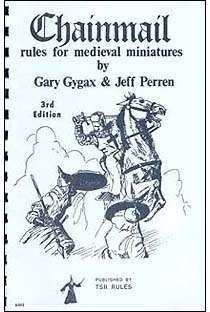Rules for Medieval Miniatures (0e)
 |
Get the fantasy miniatures game that started it all!
Chainmail is a fully fleshed out fantasy miniatures game that puts YOU in charge of your very own army. Whether you want to fight historical battles based in the trenches of reality or fantasy battles rife with magic and fantastic beasts¸ Chainmail gives you the rules to fight the wars you want to fight!
The Chainmail Medieval Miniatures section features rules for terrain¸ movement¸ formations¸ fatigue¸ and more. The Fantasy Supplement provides information for Dwarves¸ Goblins¸ Elves¸ magic¸ fantastic monsters¸ and other rules necessary for combat in a magical setting.
Note: This is a classic product¸ and not for use with the D&D Chainmail Miniatures skirmish game released October¸ 2001. "
Product History
"Chainmail" (1971)¸ by Gary Gygax and Jeff Perren¸ is the medieval miniatures system that was the progenitor of D&D. It was published in March 1971.
About the Cover. Jon Peterson has traced the origins of the illustration on the cover of "Chainmail" (1971)¸ which was penned by Don Lowry: it's a swipe of an interior picture from Jack Coggins' The Fighting Man (1966)¸ an illustrated history of fighting forces. Gary Gygax drew his own version¸ which appeared in Domesday Book #5 (July 1970) and was marked "After Coggins"¸ but that credit doesn't appear on Lowry's "Chainmail" cover.
Origins (I): A LGTSA of His Own. Gary Gygax's strong interest in wargaming began in 1967¸ when he helped to reform the International Federation of Wargamers (IFW). This wargaming organization was at the center of a vibrant fandom that communicated through numerous fanzines.
However the story of "Chainmail" truly begins when Gygax became intrigued by medieval miniatures wargames at Gen Con I (1968)¸ thanks to a demo of Henry Bodenstedt's "Siege of Bodenberg" (1967). He formed the Lake Geneva Tactical Studies Association (LGTSA) in 1969 to support his new miniatures wargaming interest¸ where he was joined by Donald Kaye¸ Jeff Perren¸ Rob Kuntz¸ and others. It would in turn become the core of the Castle & Crusade Society¸ a medieval special interest group in the larger IFW.
Origins (II): The Perren Conventions. LGTSA member Jeff Perren had been involved with the wargaming scene even longer than Gygax and had an extensive collection of ancient and medieval miniatures - including some of the Elastolin 40mm miniatures preferred for use in "Siege of Bodenberg" (1967)! He was probably the biggest proponent of the middle ages among the LGTSA players¸ which led him to write a few pages of rules for medieval miniatures wargaming. Gygax developed Perren's rules and published the "Geneva Medieval Miniatures" in the Panzerfaust fanzine (April 1970)¸ before expanding them for the Castle & Crusade Society's Domesday Book #5 (July 1970).
Origins (III): The Lowry Hobbies. Enter Don Lowry¸ another IFWer and owner of the mail-order store Lowrys Hobbies. Lowry's mail-order store mainly focused on selling miniatures; in order to improve the sales of those miniatures¸ he decided to start selling miniatures rules as well. He began with his own semi-professional variant of The Battle of the Bulge (1965) called "Operation: Greif" (1970) and followed that up by distributing the LGTSA's own Fast Rules (1970) for tanks.
Origins (IV): The Guiding Games. For Perren and Gygax's medieval miniatures rules to become "Chainmail" required a big change in Gary Gygax's life. In October 1970¸ he lost his job at the Fireman's Fund Insurance. Meanwhile¸ he'd met Lowry just a few months earlier at Gen Con III (1970). Put these factors together¸ and soon Gygax had become the editor of a new